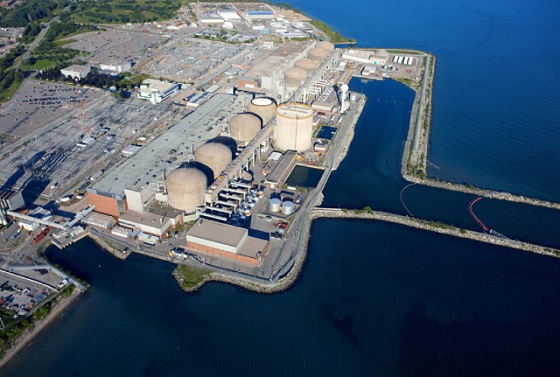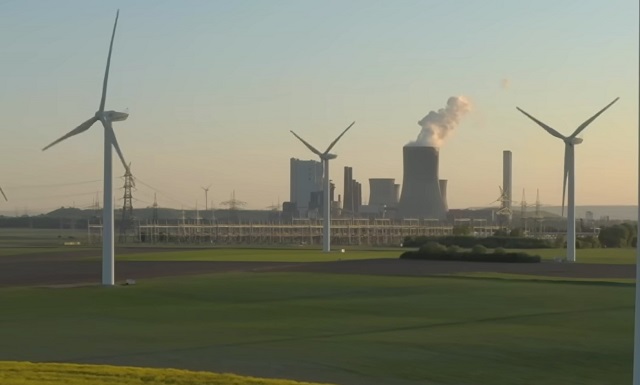Energy
Ontario Plans Major Nuclear Refurbishment to Meet Growing Electricity Demand

Pickering Nuclear Generating Station
From EnergyNow.ca
Ontario Power Generation planning to extend life of aging Pickering Nuclear Generating Station by decades
Ontario Power Generation is moving ahead with a plan to extend the life of the aging Pickering Nuclear Generating Station by decades, as the province tries to secure more electricity supply in the face of increasing demand.
Nuclear big player in getting to Net Zero
“Our province still needs this station and its workers,” he said at a press conference outside the nuclear plant. The construction phase will create about 11,000 jobs, he said, and provide about 6,000 jobs for decades.
OPG plans to spend $2 billion on engineering and design work and securing key components for the project that is expected to be completed in the mid-2030s.
Neither Smith nor OPG officials would give an estimate for how much the entire refurbishment will cost.
“It would be irresponsible at this point in time to put a number out there, because it’s this essential design and scoping and engineering work that is going to get us to the place where we can have a number,” Smith said.
OPG said a refurbishment at its Darlington Nuclear Generating Station is costing $12.8 billion and is on time and on budget.
Ken Hartwick, chief executive of OPG, said the Darlington refurbishment as well as one at Bruce Power will help guide the Pickering life extension.
“We have learned a lot about what it takes to refurbish a nuclear station the right way with thousands of lessons learned from Darlington and Bruce Power that we will apply to Pickering,” Hartwick said.
The four units produce about 2,000 megawatts of electricity, enough to power two million homes.
The Independent Electricity System Operator has said Ontario’s electricity demand is expected to grow by about two per cent each year, but could be even higher. A promise to build 1.5 million homes by 2031 and several large-scale manufacturing investments such as electric vehicle battery plants are helping to push demand higher.
The province needs more supply particularly starting in the mid-2030s, the IESO has said.
Keith Stewart, a senior energy strategist with Greenpeace Canada, said the price of wind and solar power with battery storage has “dropped like a stone” and should be more central to Ontario’s energy policy.
“Any credible independent cost-benefit analysis would find that we should be investing in the renewable-powered energy system of the future, rather than pouring billions more into rebuilding nuclear reactors long past their best-before date,” he wrote in a statement.
Pickering produces about 14 per cent of the province’s electricity but its current licence to operate the four units in question expires at the end of this year. OPG has asked the Canadian Nuclear Safety Commission to extend that to 2026, but a public hearing for that application has not yet been scheduled.
Green Party Leader Mike Schreiner said Greens understand that nuclear power will continue to be part of the energy mix for decades, but the province also needs much more wind and solar power and no more natural gas generation.
“Instead of attracting jobs and investment in low-cost renewables, the Ford government is making Ontario’s grid dirtier and more expensive by prioritizing dirty fossil gas plants and the costly, poor-performing Pickering plant,” he wrote in a statement.
The IESO announced last month that it is looking to add 2,000 megawatts of non-emitting electricity generation online such as wind, solar, bioenergy and hydro to the system. However, it also says natural gas is still required to ensure supply and stability in the short to medium term, though it will also increase greenhouse-gas emissions from the electricity sector.
Ontario’s electricity system was 94 per cent emissions free in 2020, but today that figure has fallen to 90 per cent.
The nuclear safety commission would still have to approve the Pickering refurbishment.
Two other units at Pickering are also set to stop operating at the end of this year. They are part of what’s known as the A units, which came online in the 1970s and were removed from service in 1997. Two of the units were refurbished and began operating again in 2003 and 2005.
Alberta
Game changer: Trans Mountain pipeline expansion complete and starting to flow Canada’s oil to the world

Workers complete the “golden weld” of the Trans Mountain pipeline expansion on April 11, 2024 in the Fraser Valley between Hope and Chilliwack, B.C. The project saw mechanical completion on April 30, 2024. Photo courtesy Trans Mountain Corporation
From the Canadian Energy Centre
By Will Gibson
‘We’re going to be moving into a market where buyers are going to be competing to buy Canadian oil’
It is a game changer for Canada that will have ripple effects around the world.
The Trans Mountain pipeline expansion is now complete. And for the first time, global customers can access large volumes of Canadian oil, with the benefits flowing to Canada’s economy and Indigenous communities.
“We’re going to be moving into a market where buyers are going to be competing to buy Canadian oil,” BMO Capital Markets director Randy Ollenberger said recently, adding this is expected to result in a better price for Canadian oil relative to other global benchmarks.
The long-awaited expansion nearly triples capacity on the Trans Mountain system from Edmonton to the West Coast to approximately 890,000 barrels per day. Customers for the first shipments include refiners in China, California and India, according to media reports.
Shippers include all six members of the Pathways Alliance, a group of companies representing 95 per cent of oil sands production that together plan to reduce emissions from operations by 22 megatonnes by 2030 on the way to net zero by 2050.
The first tanker shipment from Trans Mountain’s expanded Westridge Marine Terminal is expected later in May.
 Photo courtesy Trans Mountain Corporation
Photo courtesy Trans Mountain Corporation
The new capacity on the Trans Mountain system comes as demand for Canadian oil from markets outside the United States is on the rise.
According to the Canada Energy Regulator, exports to destinations beyond the U.S. have averaged a record 267,000 barrels per day so far this year, up from about 130,000 barrels per day in 2020 and 33,000 barrels per day in 2017.
“Oil demand globally continues to go up,” said Phil Skolnick, New York-based oil market analyst with Eight Capital.
“Both India and China are looking to add millions of barrels a day of refining capacity through 2030.”
In India, refining demand will increase mainly for so-called medium and heavy oil like what is produced in Canada, he said.
“That’s where TMX is the opportunity for Canada, because that’s the route to get to India.”
Led by India and China, oil demand in the Asia-Pacific region is projected to increase from 36 million barrels per day in 2022 to 52 million barrels per day in 2050, according to the U.S. Energy Information Administration.
More oil coming from Canada will shake up markets for similar world oil streams including from Russia, Ecuador, and Iraq, according to analysts with Rystad Energy and Argus Media.
Expanded exports are expected to improve pricing for Canadian heavy oil, which “have been depressed for many years” in part due to pipeline shortages, according to TD Economics.
 Photo courtesy Trans Mountain Corporation
Photo courtesy Trans Mountain Corporation
In recent years, the price for oil benchmark Western Canadian Select (WCS) has hovered between $18-$20 lower than West Texas Intermediate (WTI) “to reflect these hurdles,” analyst Marc Ercolao wrote in March.
“That spread should narrow as a result of the Trans Mountain completion,” he wrote.
“Looking forward, WCS prices could conservatively close the spread by $3–4/barrel later this year, which will incentivize production and support industry profitability.”
Canada’s Parliamentary Budget Office has said that an increase of US$5 per barrel for Canadian heavy oil would add $6 billion to Canada’s economy over the course of one year.
The Trans Mountain Expansion will leave a lasting economic legacy, according to an impact assessment conducted by Ernst & Young in March 2023.
In addition to $4.9 billion in contracts with Indigenous businesses during construction, the project leaves behind more than $650 million in benefit agreements and $1.2 billion in skills training with Indigenous communities.
Ernst & Young found that between 2024 and 2043, the expanded Trans Mountain system will pay $3.7 billion in wages, generate $9.2 billion in GDP, and pay $2.8 billion in government taxes.
Energy
Market Realities Are Throwing Wrench In Biden’s Green Energy Dreams

 From the Daily Caller News Foundation
From the Daily Caller News Foundation
For two years now, I and others have been pointing out the reality that there is no real “energy transition” happening around the world. Two new items of information came to light this week that irrevocably prove the point.
It is true that governments across the western world appear to be working to bankrupt their countries by pouring trillions of debt-funded dollars, Euros and British pounds into central planning efforts to subsidize renewables and electric vehicles into existence. That reality cannot be denied. The trouble is that no amount of debt money can turn the markets and the markets aren’t cooperating.
Despite all the government largesse that has spurred major additions of wind and solar generation capacity, those weather-reliant energy sources can’t even keep up with the pace of rising demand for electricity. As a result, the markets dictated that the world consumed record levels of coal, natural gas, oil and even wood during 2023. Yes, we are still burning vast amounts of wood for electricity, despite an alleged “transition” from wood to coal which began 500 years ago.
That is reality, dictated by the markets.
Two new bits of data came to light this week that pound the final nails into the coffin of the narrative around the energy transition. A report in the Financial Times, citing data compiled by Grid Strategies, reveals that the buildout of new high-voltage transmission lines in the United States slowed to a trickle in 2023, with just 55.5 additional miles installed. That collapse comes despite the Biden government’s recognition that a massive expansion of this type of transmission lines must happen to accommodate the demands of any true “transition” to renewables.
The Financial Times quotes a 2023 assessment by the Department of Energy that found that “regional transmission must more than double and interregional transmission must grow more than fivefold by 2035 to meet decarbonization targets.” DOE admits such a pace would add more than 50,000 miles of new transmission in just 11 years, which is almost 1,000 times the pace of adds during 2023. Yikes.
A crucial aspect of that DOE study to understand is that it was conducted before we began to understand the true magnitude of additional power demands that will result from the explosive growth of AI technology just now starting to come to full bloom. It was just this past January, at the WEF Forum in Davos, where OpenAI CEO Sam Altman told the audience he believes generation capacity on the grid will have to double over the next decade just to fill the AI demands alone. That is what is needed in addition to the rising demands for EV charging, industrial growth, population growth and economic growth.
The second piece of compelling data arising this week comes from a Bloomberg story headlined, “Data Centers Now Need a Reactor’s Worth of Power, Dominion Says.” The key thing to understand about this story is that the piece is only referencing the needs of planned new data centers being built in Northern Virginia to feed AI development in that tiny sliver of the United States.
This key excerpt from the story says it all: “Over the past five years, Dominion has connected 94 data centers that, together, consume about four gigawatts of electricity, Blue said. That means that just two or three of the data center campuses now being planned could require as much electricity as all the centers Dominion hooked up since about 2019.”
That is not just rapid growth, it is exponential growth in power demand from a single developing technology.
Demand growth needs such as this aren’t going to be filled by unpredictable, unreliable, weather-dependent generation like windmills and solar arrays. And let’s face it: The United States is not going to be able to continue expanding renewables without finding some way to create a massive expansion of transmission. Why build the generation if you can’t move the electricity?
What it all means is that all the grand Biden Green New Deal plans to shut down America’s remaining coal fleet and much of its natural gas generation fleet are going to have to wait, because the market will not allow them. That’s reality, and reality does not care about anyone’s green transition dreams.
David Blackmon is an energy writer and consultant based in Texas. He spent 40 years in the oil and gas business, where he specialized in public policy and communications.
The views and opinions expressed in this commentary are those of the author and do not reflect the official position of the Daily Caller News Foundation.
-

 conflict2 days ago
conflict2 days agoOver 200 Days Into War, Family Of American Hostage in Gaza Strives For Deal To Bring Son Home
-

 Brownstone Institute2 days ago
Brownstone Institute2 days agoBook Burning Goes Digital
-

 Brownstone Institute1 day ago
Brownstone Institute1 day agoThe Predictable Wastes of Covid Relief
-

 Bruce Dowbiggin14 hours ago
Bruce Dowbiggin14 hours agoDo It Once, Shame On You; Do It Twice, Shame On Me
-

 Alberta18 hours ago
Alberta18 hours agoGame changer: Trans Mountain pipeline expansion complete and starting to flow Canada’s oil to the world
-

 Addictions17 hours ago
Addictions17 hours agoCanada’s ‘safer supply’ patients are receiving staggering amounts of narcotics
-

 Community15 hours ago
Community15 hours agoLast Day: What would you do with $20,000 Early Bird Prize?
-

 conflict13 hours ago
conflict13 hours agoImmigration Experts Warn Possible Biden Plan To Import Gazan Refugees Would Be ‘National Security Disaster’








